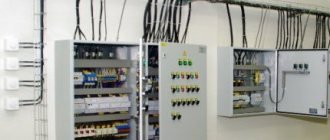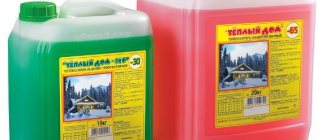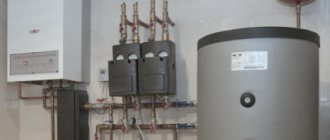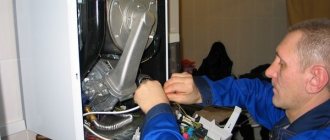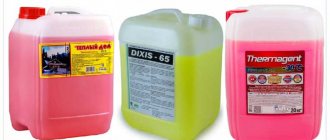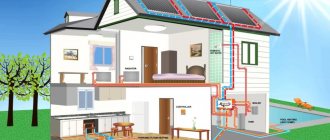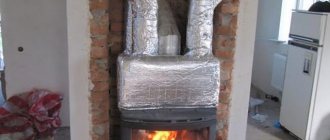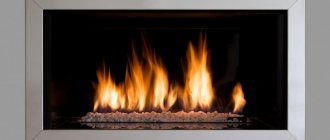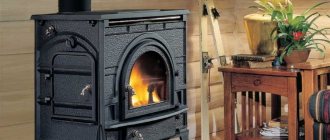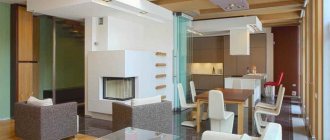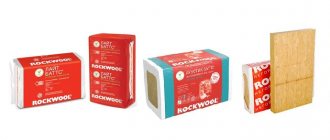Heating : Artificial heating of the room during the cold season to compensate for heat losses and maintain a normal temperature with an average lack of supply of 50 hours/year. The internal heat supply systems of a building should be understood as heat supply systems for heating, water heaters, hot water supply systems, air heaters for air handling units, air conditioners, air heating units, air heat curtains, etc. (SP 60.13330.2012).
The main task of the heating system is to create comfortable conditions for visitors to the building. The goals of automation of heating systems are:
- Efficient and economical use of heat sources;
- Facilitating system management for the building maintenance service or the owner of a private home;
- Forecasting equipment maintenance;
- Load distribution and balancing on the building’s heating network;
- Preventing equipment failure;
- Reducing the influence of the “human factor”;
- Reduced utility costs.
A combination of automation systems for heating, ventilation and air conditioning systems form an automatic microclimate control system in a building.
Types of heating systems
Heating systems are classified according to the following criteria.
According to the type of heat exchange between the heater and the environment:
Convective heating . In this case, the transfer of thermal energy occurs along with the movement of volumes of hot and cold air: the warm air flow rushes upward, the cold air flows down. Due to the heat transfer mechanism, convective heating is impossible through any impenetrable barriers, incl. transparent.
Radiant heating . This is a type of heating in which heat is transferred by radiation. From the Sun to the Earth or from the heated surface to the observer.
Convective-radiant heating . Mixed mechanism. Most heating devices (radiators, convectors, heated floors and walls) transfer heat in this particular way; the optimal option is when there is an approximately equal (50/50) ratio of convective and radiant heat.
By type of coolant:
Water heating . Today the most common type of heating, which comes in the following types:
- Radiator heating, in which the following types of radiators can be used: cast iron, steel, aluminum, bimetallic, stone, ceramic, as well as convectors.
- Warm water floor. In this case, heating communications are laid under the floor covering.
- Baseboard heating. In this case, each section of the warm baseboard is a small convector with a casing, and installation is carried out like installing a regular radiator.
- Water infrared heating (“warm ceiling”). When installing such a system, a large infrared panel is attached to the ceiling, which is a heat source.
- Combined systems: include elements of the above heating systems.
Air heating . Air systems include systems in which the coolant is heated air. In supply ventilation, such systems can be local or distributed.
In local systems, heating and air supply are carried out directly in the heated room using heating and heating and ventilation devices.
In distributed systems, air is heated in an air heating unit and supplied to rooms through ducts.
In addition, there is fire-air heating, in which heat comes from stoves and fireplaces. With this type of heating, the coolant is either practically absent, or it is hot flue gases.
Heating systems without coolant.
- Electric heating systems. In such systems, electrical energy, converted into heat, heats the room rather than the coolant, for example, electric fireplaces, infrared electric panels, electric radiators or floors.
- Gas systems. In such systems, heat is generated by the combustion of a gas-air mixture. An example is gas fireplaces. picture of galley heating
OpenTherm protocol, modulating burners and weather-compensated automation
Nowadays, the most modern and high-tech heating control systems are equipment that supports the OpenTherm protocol. There are three main features that distinguish devices with OpenTherm from the examples above.
Flame modulation control
Flame modulation – regulation of heating power. The creation of new gas boilers with burners that control flame modulation contributed to the emergence of new opportunities for organizing more efficient and economical operation of heating systems. If the power is too high, the boiler switches on and off frequently (clocking), and if the power is low, achieving the set temperature becomes impossible. Therefore, the best flame modulation is considered to be the combustion level at which the boiler does not turn off, but the set temperature value is reached. None of the boiler control methods described above can control flame modulation. To work with the new burners, the OpenTherm protocol was invented, which makes it possible to effectively establish a connection between the capabilities of the new burners and modern weather-sensitive automation and electronics.
Working with automation
We can say that OpenTherm is a bridge built between boiler manufacturers and manufacturers of other automation and electronics. A single protocol standardly describes all the main commands for working with modulating burners. This allows you to connect a wide variety of equipment to it: from a thermostat to programmable temperature controllers, to which up to 10 temperature sensors can be connected. Modern thermal controllers are programmable devices that process the readings of temperature sensors located both in various zones of a heated facility and on the street. The heat controller maintains the set temperature and can change it depending on user commands, time of day or day of the week. Analyzing the received temperature data outside and inside the room, the controller sets a weather-dependent operating mode for the modulating burner of the boiler and pumps. On the graph we can see that the burner practically does not turn off, but only changes the intensity of its combustion. At the same time, regardless of external conditions, the target temperature graph practically does not change and lies within the hysteresis limits of the heating system. Also, the advantages of this control system are a noticeable increase in the service life of the burner and significant savings in gas fuel.
Access to automation settings and fixing errors
Among other things, the OpenTherm protocol provides the opportunity to gain full access to the boiler automation settings and change them from any control device (smartphone, tablet or desktop computer).
The protocol also provides the owner of the heating equipment, as well as maintenance personnel, with all the information about errors that occurred during the operation of the heating equipment. Advantages:
- Minimum fuel consumption compared to other control methods;
- Minimal fluctuations in air temperature in the house, regardless of the temperature outside, which ensures maximum comfort;
- The temperature is adjusted by changing the modulation of the burner flame, which minimizes the number of on/off cycles;
- Possibility of remote monitoring of the boiler condition and changing its settings.
Flaws:
- Higher price compared to other equipment, which is compensated by gas savings.
Heating system elements
Which elements can be used (and automated).
Boilers . The main element of any system, since this is where the process of fuel combustion occurs, after which the heat released during this process is transferred to the coolant (water or antifreeze).
According to the type of energy carrier, boilers are:
- gas;
- electrical;
- liquid fuel;
- solid fuel;
- combined;
- alternative, for example, solar collectors.
Depending on the number of coolant circulation circuits, boilers are:
- Single-circuit – intended for heating only;
- Multi-circuit – also used to heat water or turn on a heated floor system.
Burners . They are installed on gas boilers and can be fan-powered (with a supercharger) or atmospheric. Fan burners are noisier, but can operate at any incoming gas pressure.
Heating temperature chart . In apartment buildings, public and industrial buildings, boilers and burners are replaced by thermal power plants or thermal power plants. From the station, through the heating main systems, the heated steam enters the district heating district, and from it, in turn, to the building’s heating and heating system. From the heated coolant, in accordance with the temperature schedule, heat is transferred through ITP heat exchangers to the heating, ventilation and hot water circuits. At the outlet of their heat exchangers, the temperature of the coolant returning to the network must correspond to the temperature schedule.
Example of a temperature graph. Click to expand
| Outdoor air temperature Тнв, оС | Temperature of network water in the supply pipeline Т1,оС | Water temperature in the supply pipeline of the heating system Т3, оС | Water temperature after heating system T2, оС | |||
| 150 | 130 | 115 | 105 | 95 | ||
| 8 | 53,2 | 50,2 | 46,4 | 43,4 | 41,2 | 35,8 |
| 7 | 55,7 | 52,3 | 48,2 | 45,0 | 42,7 | 36,8 |
| 6 | 58,1 | 54,4 | 50,0 | 46,6 | 44,1 | 37,7 |
| 5 | 60,5 | 56,5 | 51,8 | 48,2 | 45,5 | 38,7 |
| 4 | 62,9 | 58,5 | 53,5 | 49,8 | 46,9 | 39,6 |
| 3 | 65,3 | 60,5 | 55,3 | 51,4 | 48,3 | 40,6 |
| 2 | 67,7 | 62,6 | 57,0 | 52,9 | 49,7 | 41,5 |
| 1 | 70,0 | 64,5 | 58,8 | 54,5 | 51,0 | 42,4 |
| 0 | 72,4 | 66,5 | 60,5 | 56,0 | 52,4 | 43,3 |
| -1 | 74,7 | 68,5 | 62,2 | 57,5 | 53,7 | 44,2 |
| -2 | 77,0 | 70,4 | 63,8 | 59,0 | 55,0 | 45,0 |
| -3 | 79,3 | 72,4 | 65,5 | 60,5 | 56,3 | 45,9 |
| -4 | 81,6 | 74,3 | 67,2 | 62,0 | 57,6 | 46,7 |
| -5 | 83,9 | 76,2 | 68,8 | 63,5 | 58,9 | 47,6 |
| -6 | 86,2 | 78,1 | 70,4 | 65,0 | 60,2 | 48,4 |
| -7 | 88,5 | 80,0 | 72,1 | 66,4 | 61,5 | 49,2 |
| -8 | 90,8 | 81,9 | 73,7 | 67,9 | 62,8 | 50,1 |
| -9 | 93,0 | 83,8 | 75,3 | 69,3 | 64,0 | 50,9 |
| -10 | 95,3 | 85,6 | 76,9 | 70,8 | 65,3 | 51,7 |
| -11 | 97,6 | 87,5 | 78,5 | 72,2 | 66,6 | 52,5 |
| -12 | 99,8 | 89,3 | 80,1 | 73,6 | 67,8 | 53,3 |
| -13 | 102,0 | 91,2 | 81,7 | 75,0 | 69,0 | 54,0 |
| -14 | 104,3 | 93,0 | 83,3 | 76,4 | 70,3 | 54,8 |
| -15 | 106,5 | 94,8 | 84,8 | 77,9 | 71,5 | 55,6 |
| -16 | 108,7 | 96,6 | 86,4 | 79,3 | 72,7 | 56,3 |
| -17 | 110,9 | 98,4 | 87,9 | 80,7 | 73,9 | 57,1 |
| -18 | 113,1 | 100,2 | 89,5 | 82,0 | 75,1 | 57,9 |
| -19 | 115,3 | 102,0 | 91,0 | 83,4 | 76,3 | 58,6 |
| -20 | 117,5 | 103,8 | 92,6 | 84,8 | 77,5 | 59,4 |
| -21 | 119,7 | 105,6 | 94,1 | 86,2 | 78,7 | 60,1 |
| -22 | 121,9 | 107,4 | 95,6 | 87,6 | 79,9 | 60,8 |
| -23 | 124,1 | 109,2 | 97,1 | 88,9 | 81,1 | 61,6 |
| -24 | 126,3 | 110,9 | 98,6 | 90,3 | 82,3 | 62,3 |
| -25 | 128,5 | 112,7 | 100,2 | 91,6 | 83,5 | 63,0 |
| -26 | 130,6 | 114,4 | 101,7 | 93,0 | 84,6 | 63,7 |
| -27 | 132,8 | 116,2 | 103,2 | 94,3 | 85,8 | 64,4 |
| -28 | 135,0 | 117,9 | 104,7 | 95,7 | 87,0 | 65,1 |
| -29 | 137,1 | 119,7 | 106,1 | 97,0 | 88,1 | 65,8 |
| -30 | 139,3 | 121,4 | 107,6 | 98,4 | 89,3 | 66,5 |
| -31 | 141,4 | 123,1 | 109,1 | 99,7 | 90,4 | 67,2 |
| -32 | 143,6 | 124,9 | 110,6 | 101,0 | 94,6 | 67,9 |
| -33 | 145,7 | 126,6 | 112,1 | 102,4 | 92,7 | 68,6 |
| -34 | 147,9 | 128,3 | 113,5 | 103,7 | 93,9 | 69,3 |
| -35 | 150,0 | 130,0 | 115,0 | 105,0 | 95,0 | 70,0 |
Read more about ITP automation.
Air valves . Serve to remove air from the system. Such valves are found in heating radiators and risers. Many are familiar with the Mayevsky manual valve.
Expansion tanks . As the temperature rises, the internal hydraulic pressure in a closed system filled with water increases, and to prevent an accident, excess water enters the expansion tank. If the system does not have a boiler, then an expansion tank is not required.
Circulation pumps . They are used for the movement of coolant in a system with forced circulation.
Pipeline system . They are used to move coolant through them; they are made of steel, copper and polymer.
Radiators, heated floors . Final heating devices. They are used for heating the room; they are made of steel, cast iron, aluminum and bimetallic.
sensors , flow meters, speed controllers and thermostats. All these tools are used to monitor system parameters, eliminate accidents, and control the system, manually or automatically.
Reducing the cost of paying for thermal energy
Automation of ITP is one of the most effective tools for reducing the cost of paying for thermal energy.
4.1. Automation of the ITP ensures regulation of the temperature of the water entering the heating system, depending on the outside air temperature. This allows you to reduce the “overheating” of the building in the autumn-spring period and thereby reduce the “useless” costs of thermal energy. 4.2. An additional reserve for saving thermal energy is adjusting the temperature of the coolant supplied to the heating system based on the temperature of the return water, taking into account the actual operating mode of the heating supply organization. 4.3. Maintaining the water temperature in the return pipeline in accordance with the temperature of the coolant in the supply pipeline of the heating network (see clause 3.3) allows you to avoid claims and penalties from the heating supply organization. For example, CHPP-5, in the case of systematically exceeding the average daily return temperature by more than 3°C, charges an additional payment for “underused thermal energy”. This value is determined by the formula:
∆Wunderperform.= M2∙(T2F-T2GR)/1000
∆Wunderutilized – The value of “underutilized thermal energy” for the monthly calculation period, Gcal.
M2 – amount of coolant for the heating system; ventilation for the estimated monthly period, T;
T2F – actual return water temperature, °C;
Т2ГР – return water temperature corresponding to the temperature in the supply pipeline of network water, °C;
1000 – coefficient for conversion to Gcal.
Practice shows that the value of ∆W is underperformed. reaches 50% of the total heat consumption for 1 month.
4.4. Modern controllers allow you to use a setpoint (correction) to the set temperature of the water entering the heating system. This installation allows you to automatically lower the temperature in production premises at night and on weekends, then increase it during working hours. Residential buildings use automatic temperature reduction at night. Thus, automation of heat consumption provides significant savings in thermal energy, which reaches 50%.
What and how to automate? Basic principles
Depending on the type of coolant heating system, the control and parameters controlled by the automation system will differ.
In general, the operator sets the desired temperature in the room, via the control panel or via a PC, via a remote control in a separate room, etc.
The heating automation system, based on data on the air temperature in the building, the outside air temperature, the time of day, and the presence of people in the room, selects an operating mode and transmits control signals to actuators, which may differ:
A) To control the electric heating system, devices are used that control the power of the electric current: bimetallic thermostats operating on the “on/off” principle, or thyristor voltage regulators, with the help of which, when the voltage decreases, the power consumption of the device is also reduced. As an example, we can recall an electric convector, the user sets the required temperature, and the thermostat maintains the temperature by turning on and off the power supply to the device.
B) To control a heating system with a coolant circuit, devices are used that regulate the temperature and flow of the coolant. At the same time, adjusting the temperature of the coolant is possible only in autonomous systems with boilers and heaters, for example, in private houses; for centralized heating systems, the temperature of the incoming and outgoing coolant flows is given by the graphs:
- from large thermal power plants: 150/70°C, 130/70°C or 105/70°C;
- from boiler houses and small thermal power plants: 105/70°C or 95/70°C.
Thus, at large facilities, room temperature control can only be carried out using devices that change the coolant flow in the heating network and maintain it at a given level, so as not to go beyond the temperature schedule.
Principle of weather-compensated heating control
Let us explain how room temperature is maintained taking into account changes in outside temperature. When setting up the controller, a so-called temperature curve is established, reflecting the dependence of the temperature of the coolant in the heating circuit on changes in weather conditions outside. This curve is a line, one point of which corresponds to +20°C outside (in this case, the temperature of the coolant in the heating circuit is also +20°C, since it is believed that under such conditions there is no need for heating). The second point is the coolant temperature (say, 70°C), at which even on the coldest day of the heating season the temperature in the room will remain set (for example, 23°C). If the building is not insulated sufficiently, a slightly higher temperature of the coolant in the heating circuit will be required to compensate for heat loss. Accordingly, the slope of the curve will be steep. And vice versa, if everything is in order with the thermal insulation of the house. When making a controller, many similar curves are entered into the device’s memory so that you can then select from the entire family the appropriate line specifically for the conditions of your home.
As a rule, to create the maximum level of thermal comfort, as well as to save fuel, a single street sensor is not enough. Therefore, an additional sensor is often installed inside a heated room. The presence of two sensors at once, both indoor and outdoor, allows you to accurately monitor and quickly adjust the temperature in the premises of the house.
Typically, a room temperature sensor is installed in the so-called reference room - the temperature in it will correspond to your concept of a comfortable thermal background. This room should not be heated by direct sunlight or exposed to drafts. As a rule, children's and bedrooms are chosen as a standard. Installing a room sensor makes it possible to enable the self-adaptation mode, in which the heating curve is selected for the appropriate room automatically - by the microcomputer of the control panel itself. In addition, a room sensor is often integrated into a thermostat, with which you can set the desired temperature and its average level throughout the house. Local temperature control in a single room is achieved by installing thermostatic valves with thermal heads on radiators.
A very important aspect of using a thermostat is, again, fuel economy. Let us explain how it is carried out. Let’s say that guests gathered in the room where the sensor is installed and the temperature increased by 2°C due to the natural heat generation of people. The control panel detects these changes and gives a command to reduce the temperature of the coolant in this circuit, although the street sensor may require just the opposite. Reducing the heat consumption to heat this room naturally saves fuel. But there are also problems here. Flooding the fireplace in the room where the thermostat is set, or leaving a window open for too long, can change the temperature throughout the house. To take into account such factors, many systems provide the possibility of making amendments to the control algorithm by setting the coefficient of influence of the room sensor on the nature of the heating curve. But in general, experts simply do not recommend installing room temperature measuring devices near fireplaces, entrance doors, windows and other sources of heat or cold that can introduce an error in the measurement results.
It should also be noted that installing only a room thermostat, without an outside temperature sensor, significantly increases the inertia of the temperature control system. Changes in the thermal background will occur with a delay, since the automation will begin to operate only when the temperature in the house, for example, drops, and this will happen later than the actual cold snap outside
Modern controllers not only monitor the weather, but also have a fairly large number of functions, some of which are user, and some are service. If the former guard comfort, the latter monitor the condition of the system and ensure the correct and safe operation of the equipment.
Main components of the heating automation system
- temperature (indoor, outdoor, coolant) and pressure sensors, which provide a constant supply of information about the state of the heating system;
- thermostats (setters, thermostats) that regulate the coolant supply;
- drives and actuators (valves, circulation and make-up pumps, frequency regulators) perform the function of regulatory and safety mechanisms that ensure reliable and trouble-free operation of the system.
- automation panels (controllers, expansion modules) that control the heating system
Sensors
The sensors are designed to monitor pressure and temperature indoors, outdoors and coolant in the pipelines of the heating system.
Temperature sensors are:
Submersible . Designed to take readings about water heating in pipes. Their installation is carried out in certain areas of the system. These sensors are bimetallic and alcohol
Remote . This type of sensor is installed outside the heating system. Recently, wireless models have become popular, which transmit information using auxiliary electronics, which makes it possible to install them almost anywhere - in a separate room or outdoors.
Pressure sensors can be mechanical - pressure switches (mechanical measurement of pressure difference and electrical conversion) and analog pressure sensors (conversion of pressure directly into an electrical signal, for example, using piezo elements).
Programmers and thermostats are the main heating control elements
Heating programmer
To organize autonomous heat supply, you will need electronic devices. They may have a heating boiler control panel and the ability to simultaneously change steam meters in several connected components.
These devices are called programmers or electronic thermostats. Like other similar devices, they can have heating control via SMS or the Internet. But these are just additional functions. To select the optimal model, you need to know the basic functional qualities of the programmer:
- Number of connected circuits . Can vary from 1 to 12. An additional module is installed to increase the number of connectors;
- System operating modes . Depending on the settings, you can set the control of heating radiators in economy, normal and comfortable modes;
- Plug-in module – heating control by phone . The GSM station transmits the required information via SMS - coolant temperature, emergency mode notification, etc.;
- The presence of radio transmitters to create wireless communication channels between connected heating components.
Collectively, the installed equipment is called the heating control frame. It may consist of components with different functionality. The purpose remains the same - the ability to automatically or semi-automatically change heat supply parameters.
Connecting the programmer to the boiler
But in addition to local devices, there are also zonal ones, installed on specific components - boilers, radiators. By controlling heating via the Internet using these devices, you can regulate the degree of water heating in the system and the temperature regime in a specific battery. Often such devices are called not programmers, but electronic thermostats.
They are more affordable and easy to install. Thermostats do not require a heating control cabinet, which reduces the complexity of installation. In some cases, it is possible to connect several thermostats to a single control unit.
What should you consider when creating a smart heating budget? In addition to the cost of the control element, you need to know the approximate price of consumables - communication wires, heating control panel. The latter is necessary when installing a system consisting of several blocks - a programmer, a GSM module, expansion strips for additional contactors.
| Model | Purpose | Cost, rub. |
| Computherm Q3 | Wired thermostat | 1625 |
| Computherm Q3 RF | Wireless thermostat | 3367 |
| PROTHERM Kromschroder E8.4401 | Programmer. Control of 4 boilers, DHW, 15 heating circuits | 34533 |
| Heating control panel | RCD, boiler control units, connection to temperature sensors | From 7000 |
It is also important to consider the location - the heating control box should be installed in an accessible place. Its installation in a boiler room is not recommended, although this is the simplest option in terms of labor intensity. It is best to install it in a living room. Then it will be possible to monitor and change system parameters much more often.
Programmer models differ in the number of connected system components. They are called control circuits.
Thermostats
Thermostats are a control element of the system and can be mechanical or electronic.
Mechanical thermostats consist of a thermal head (sensing element) and a valve. The working fluid of the sensitive element is a liquid, gas or elastic element that changes its shape depending on temperature. When the air temperature in a heated room changes, the volume of the working fluid changes. The sensing element reacts to this and moves the regulator valve stem. This changes the flow area in the channel.
Electronic thermostats (ET) . This is an automatic device consisting of several devices that ensure the maintenance of a given temperature in thermal installations. In the heating system, they automatically control the operating modes of equipment and actuators (boilers, mixers, pumps, valves, etc.), and the result of their operation is the creation of a temperature regime specified by the user in the room.
Digital thermostats come with “open” and “closed logic”. Closed logic implies strict control algorithms and a certain set of external devices connected to the system (sensors, actuators). Only limited parameters can be changed; the user cannot program control algorithms.
In large systems, thermostats with open logic are used - these are freely programmable controllers with a wide range of settings and functions. They can be integrated into a centralized building management system. Mounted in automation panels. Installation and configuration of such thermostats requires certain qualifications.
Our equipment
The automated complex consists of modules, each of which performs specific functions:
- The control controller is the main module with a programmable microprocessor. On it, the specialist sets the data that the automation system will use in its work. For example, you can adjust temperature settings depending on the time of day to optimize costs. So, at the end of the working day, the power of the equipment will decrease, and before it starts, the system will switch to high performance mode. The module makes all adjustments automatically, without human intervention. You can set up continuous data collection with subsequent adjustment of temperature values. Controllers coordinate the operation of all elements of the complex based on the information transmitted by sensors.
- Sensors These are thermal devices that determine the temperature of the coolant and the environment. This data is converted into commands and sent to the controller. The task of the sensors is to record the real parameters of the object. This information may relate to temperature, humidity, pressure. We individually select sensors for operating conditions.
- Control Panel. It contains switches that you can use to manually control the controllers. The panel has an informative display that simplifies control. You will be able to monitor system parameters in real time, check the compliance of actual indicators with standard ones, and make timely adjustments.
- Temperature regulators. These are electronic and mechanical devices designed to adjust the cross-section of pipes depending on the needs of the facility and external conditions. By changing the throughput of the channels, you can increase or decrease the volume of coolant supplied to the radiators.
Actuator drives
Valve drives can be threshold (two or three position) and analog, with the possibility of smooth regulation.
The most famous and common method of regulation in a pumping system is regulation by a damper when the engine is running at full speed, and pressure regulation in the system is carried out using shut-off valves (gate valves, taps, bends, ball valves, etc.). The operation of the pump is ensured by a constant supply of energy to it from an electric motor, and it is controlled by a pressure control device.
Regulating the throttle can be compared to driving a car: when the gas pedal is pressed all the way, the speed of movement is regulated by the brake pedal.
A more economical way to control coolant flow is to use frequency converters to regulate the rotation speed of heating system pump motors.
With this method of regulation, up to 50% savings in energy consumption are achieved, and if we take into account that during its service life the engine consumes electricity in an amount that far exceeds its cost, then this indicator turns out to be extremely relevant. For example, an 11 kW engine operating for 8 hours a day throughout the year will consume electricity in the amount of about 145 thousand rubles. (at a tariff of 4.5 rubles/kWh).
Manual control of the heating boiler
Until a certain point, the most common way to control a heating boiler was to manually control the temperature of the coolant (many boilers are still controlled this way).
Automation was simple - the thermostat built into the boiler was manually adjusted to a certain temperature of the coolant circulating in the system, for example, 50°C. But manual control is effective only under stable external conditions. Let’s assume that it is necessary to maintain a certain temperature in the room – 23°C. When the coolant temperature reaches 50°C, the thermostat will give a command to turn off the gas burner, and if the temperature drops, it will turn it on. This cyclic process explains the “waviness” of the orange coolant temperature graph and the green room temperature graph. If it gets sharply cold outside and the thermostat continues to operate as before (50°C), the temperature in the room will inevitably drop. To correct this situation, the participation of a person is required, who must increase the coolant temperature to higher values. The disadvantages of this method of regulation are obvious - this is the involvement of a person in the operation of the heating system and the continuous operation of the automatic ignition of the burner.
Advantages:
- High accuracy of maintaining a stable temperature in the house at a constant temperature outside;
- There is no need to pay extra for automatic control, because it is included in the price of the boiler.
Flaws:
- The need for constant manual adjustment of the temperature regime of the boiler;
- Due to the constantly running pump, increased energy consumption occurs;
- Frequent on/off cycles wear out the boiler automation faster.
Automation boards
Heating automation panels are used to control the heating system. They are used to control circulation pumps, control valves with pulse or analogue control, gate valves and solenoid make-up valves.
The automation panel can be equipped with temperature, pressure and differential pressure sensors, or the manufacturer indicates a list of compatible equipment.
Functions implemented in automation panels:
- Regulation of supply and return coolant temperatures for heating systems;
- Maintaining the specified value of the selected parameter, regulating the parameter according to the network diagram;
- Enabling energy saving modes at night, on holidays and weekends, controlling circulation pumps, lowering the temperature of hot water in the circulation circuit;
- Protection against valve sticking (periodic run);
- Control of the operation of the main and backup pumps with the organization of their alternating operation, automatic transfer switch and protection against “dry running”;
- Automatic restart of pumps in case of power failure;
- Other functions.
When connecting sensors to a heating automation panel, take into account the type of signal transmitted by the converter - analog, discrete or threshold - open/closed. Expansion modules that control device drives are selected based on the same principles, taking into account the type of control signal and control protocol.
Boiler control using a room thermostat
Another popular and more modern way to regulate the operation of a heating boiler and exclude human participation from this process is to use a relay room thermostat in the heating system.
A thermostat is a device that measures the temperature in a living room and, depending on the environment and the set temperature value, controls the turning on and off of the boiler’s gas burner. However, the inertia of the thermal system causes large delays in responding to commands from the room thermostat. And often the temperature in a living room differs significantly from the set one (up or down), which is displayed on the green graph of room temperature in the form of the appearance of red (overheating) and blue (underheating) segments.
It should be noted that for faster heating, the boiler is set to a higher coolant temperature (in our case, 80°C). Hence the certain “crescent” shape of the orange graph - we see rapid heating to 80°C, and then turning off the burner and gradual cooling until the room thermostat again commands the burner to turn on. If the outside temperature drops, the thermostat will turn on the burner more often, and the lower limit of the coolant temperature (red “ON” dot on the orange graph) will increase, which compensates for the decrease in outside temperature. Thus, with the help of a thermostat, it has become possible to stabilize the room temperature without human intervention, although short-term cyclic “overheating” and “underheating” are possible.
When using a relay thermostat, the automatic ignition operates much less frequently than with manual control, but due to the high threshold value of the coolant temperature, excessive consumption of gas fuel occurs.
This disadvantage can be compensated for by improving room thermostats. Thus, modern programmable models of these devices allow you to set various daily and weekly operating modes. For example, the temperature in rooms can be lowered at night and raised during the day. Likewise on weekdays and weekends. A flexible schedule of the required temperature allows you to achieve significant gas savings. Advantages:
- Elimination of human participation from the process of adjusting the operation of the boiler;
- Reducing the number of boiler on/off cycles, which has a beneficial effect on the service life of the automatic ignition system;
- Saves electricity by automatically turning off the pump when the burner is off.
Flaws:
- Costs for purchasing and installing a thermostat;
- There may be noticeable fluctuations in air temperature in the room.
Heating automation system design
The equipment and algorithms of the heating system automation project are carried out using the technology of the heating system developers. A typical project composition may be as follows:
- Common data;
- Structural diagrams, if necessary;
- System programming task;
- Functional automation diagrams for each of the subsystems - automation panels will be assembled according to them;
- Communication diagrams of automation system controllers;
- Connection diagrams with related automation systems;
- Diagrams of external connections for automation panels (in fact, this is a table of connections);
- Schematic electrical diagrams of automation panels, pump motors, valve controls;
- Schematic diagrams of power supply for automation panels;
- Layout of equipment and wiring of automation systems;
- Cable magazines;
- Installation diagrams;
- Specification of equipment and wiring.
System operating modes. Work in the building automation and dispatch system
Heating control systems can operate in the following modes.
Manual mode . In this case, setting operating modes, switching equipment from primary to backup and many other functions are carried out manually by the operator, and it does not matter whether he presses buttons on the automation panel or on the PC, this is manual mode.
Automatic offline mode . In this case, the operator turns the system on and off; subsequently, the system operates according to a given algorithm and transmits information about its state to the operator or dispatcher.
Automatic as part of an automated building management system. In this mode, the operation of the heating system is synchronized with other life support systems of the building; the operator or dispatcher does not take part in the control.
Modules for remote control of heat supply
Heating control modules
To organize a home heating control system, you need to take care of the possibility of remote control. Special modules will help provide this function. Most often, they are not included in the standard package of programmers and thermostats.
After purchasing a home heating control unit, you should choose the right communication device. Depending on the technical requirements, it can provide the following types of communication between the user and the control element:
- GSM control . Data is transmitted using cellular communications. In fact, this is a landline telephone with the functions of generating, sending, receiving and processing SMS messages;
- Connection via the Internet . It is characterized by more expanded functionality and is practically not limited geographically. In this case, the heating boiler control panel can be a tablet, laptop or any PC with a special software package installed.
To do this, the programmer must have flexible settings. Arduino heating control systems have this capability. In fact, they can be adapted for any scheme, from ventilation control to complex production complexes.
When traveling abroad, it is not recommended to activate roaming to control heating via the GSM module. This will entail large costs. It is best to entrust control of the heat supply to a friend or relative.
GSM boiler control unit
GSM data transmission unit
The simplest and relatively affordable way to control the operation of the boiler is to install heating control via SMS. For this, a separate unit is purchased, which is connected to a programmer or thermostat. Some models already have a similar function.
At the stage of choosing a remote heating control, you should decide on the method of data transmission via the GSM network. This largely depends on the capabilities of the specific phone model, as well as the built-in functions of the data transmission unit.
The easiest way to receive messages is in the form of SMS. The unit installed in the heating control frame will transmit the following data:
- A drop in temperature and pressure below (above) a critical level;
- Emergency failure of the boiler - power outage, lack of energy. In this case, it is possible to transmit the error code and its description.
A unit with a built-in SMS notification module.
To reverse control the heating by phone, you need to send SMS of a certain format. With their help, you can adjust the temperature level and initiate the startup of the boiler after an emergency shutdown. Also, many models have a built-in command delay function. Those. the value of a parameter is transmitted, and the activation time of the boiler to achieve it is indicated.
It is important to remember that the data obtained may differ from the actual data. To effectively control heating radiators, it is necessary to know the degree of error of the following devices:
- Temperature sensors . The readings of most electronic models have an error of ±0.5°C;
- Temperature change step in the thermostat . It can range from 0.2°C to 0.5°C.
In practice, this is really necessary when setting the heating to anti-freeze mode, when the heating level of the coolant is maintained at +5°C. This allows you to save on energy costs and at the same time avoid emergency situations.
To install the GSM unit, you do not need to purchase a special heat supply control cabinet. This device is rarely controlled, so you can limit yourself to installing a closed switchboard.
Heating control via the Internet
Receiving heating data on a smartphone
Controlling heating via the Internet has all the advantages inherent in controlling heat supply using SMS messages. However, the ability to receive more information affects the quality of heat supply.
The functions of the cottage heating control unit when connected to the Internet have a number of advantages. The main one is the ability to install special software systems. They are integrated into a laptop, smartphone or any other type of personal PC. At the same time, remote control of heat supply has the following capabilities:
- User-friendly interface . Most often it is designed for smartphone operating systems. But with a little modification it can be installed on a computer;
- There is no limit on the number of connected users , as in SMS blocks;
- Ability to configure settings from any point where there is Internet. In this case, there is no need to enable roaming. The exception is Internet services from mobile operators.
It is important to correctly preset the remote control for the heating boiler. To do this, it is recommended to first check the actual readings of the system after they have been changed. This is necessary to calibrate the system.
Some models of Internet blocks installed in the heating control frame have operating system restrictions. The most commonly used OS is Android or IOS.
Automation of heating of a private house
Heating system installations for private houses are equipped with automation systems; as a rule, they are closed and come with a set of all necessary sensors and regulators.
The main tasks that automation of heating of a private house solves are:
- control of heating boiler operation;
- providing comfortable living conditions;
- saving fuel and operating equipment in optimal mode.
Setting up an automation system for home heating systems is often quite simple and is carried out either by the owner of the building or by the organization that installed the system itself.
Preparatory work
Before starting work on heating installation in a private house, it is necessary to carry out preparatory work. Their goal is to reduce the possibility of downtime for the installation team to a minimum during the work process. Preparatory work includes:
- Ensuring construction readiness - the thermal circuit must be closed, the premises must be cleared of construction debris, there must be interfloor ceilings or joists
- Construction of niches for the installation of radiators and manifold cabinets - if necessary
- Preparing the wall surface for installing radiators - preferably a fine finish
- Complete finishing of the boiler room
- Making all the necessary holes in the interfloor ceilings, making grooves and niches
Read other articles on this topic
| How to save on heating a country house | Water heating in a private house |
| Country house heating system | Heating a private house from metal-plastic pipes |
| Heating a private house with a heat pump - pros and cons | Heating diagram for a two-story house |
| Heating a private house with convectors | Heating and water supply of a country house: description of installation technology |
| Heating wiring diagrams from a boiler in a private house | Autonomous heating of a private house |
| Heating system for a private house using a warm baseboard | Heating the house with liquefied gas |
| Gas consumption for heating a private house - consumption calculation | Heating distribution for a two-story house |
| Collector heating system for a private house | Heating a private house with electricity |
| Basic rules for the location of radiators when heating a private house | Installation of a heating system in a private house |
| Heating your home is the most economical way | How to heat your home without gas |
| Features of heating a country house with electricity | About heating schemes for a private house with a gas boiler |
| Infrared heating of houses | Heating project for a private house |
| Heating a private house with forced circulation | The best heating for a private home |
| Heating a private house with underfloor heating | Heating options for a frame house |
| Do-it-yourself heating of a private house made of polypropylene | Installation of a heating system: rules and description |
| Combined heating system for a private house | Heating system for a private house with natural circulation |
Services on this topic
| Heating design | Turnkey solid fuel heating |
| Turnkey gas heating | Turnkey heating |
| Heating in a turnkey wooden house | Turnkey water heated floor |
| Installation of water heated floor | Heating a two-story house |
| Heating installation in a cottage | Heating a country house: options and prices |
| Heating installation | Heating installation in a private house |
| Installation of plumbing and heating engineering systems | Diesel heating of a country house |
| Autonomous heating on a turnkey basis | Air heating of a country house |
| Prices for heating installation in a private house | Design and installation of heating systems |
| Water heating in a private house | Electric heating of a country house: options and prices |
| Heating in a townhouse | Gas heating design |
| Heating design cost | Heating calculator for a private house |
| Installation of water heated floors in a private house | Price for installing a water heated floor |
| Installation of water heated floors on a wooden floor |
